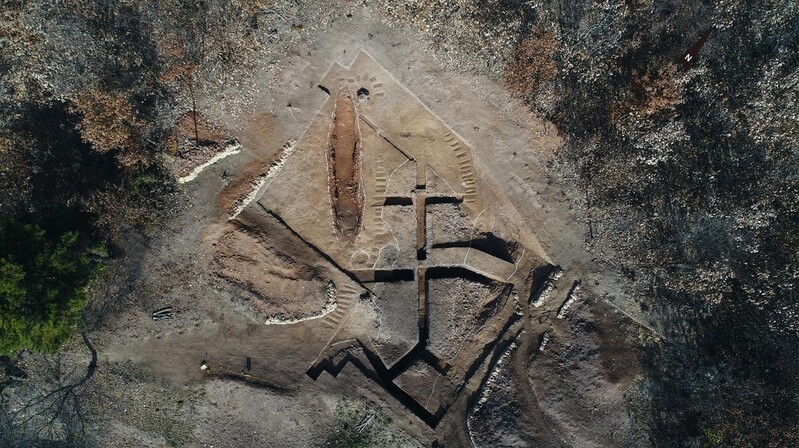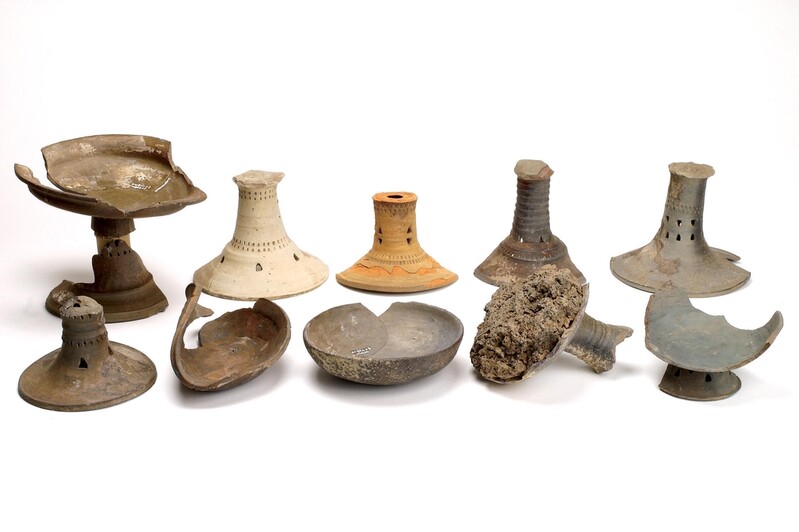 |
| ▲This photo, provided by Gyeongsangnam-do, shows Haman Ugeo-ri earthenware kiln area. (PHOTO NOT FOR SALE) (Yonhap) |
 |
| ▲This photo, provided by Gyeongsangnam-do, shows dishes from Haman Ugeo-ri earthenware kiln area. (PHOTO NOT FOR SALE) (Yonhap) |
SEOUL, August 25 (Yonhap) -- Gyeongsangnam-do announced on Thursday S.Korea’s largest kiln site of Gaya pottery “Haman Ugeo-ri Earthenware area” is scheduled to be appointed as monument.
Haman Ugeo-ri Earthenware area, located on the slopes of Mt. Cheonje (224.9 m above sea level) in Gaya-eup and Beopsu-myeon, Haman, is where large scale of Gaya pottery was produced.
Its value as important Gaya relic, which can investigate the production and distribution of ancient earthenware, was recognized through Cultural Properties Committee’s review and was announced to be soon designated as cultural asset.
Gyeongsangnam-do explained that the area around Mt. Cheonje, tangent to the Namgang River, has an optimal environment to obtain high-quality clay, which is a raw material for earthenware production, and to transport produced earthenwares to the outside.
According to the “Basic Academic Research on Gaya Pottery Production Sites in Haman” GAYA National Research Institute of Cultural Heritage
According to the 'Basic Academic Research on Gaya Pottery Production Sites in Haman' of the GAYA National Research Institute of Cultural Heritage, there are 18 pottery kiln sites from the Gaya period in Haman, the ancient city of Aragaya, and 16 places are concentrated in the area of Mt. Cheonje. There are two sites where excavations are predicted.
The excavation of the Ugeori pottery kiln area first began by the Gimhae National Museum in the area around 215 Ugeori (Ugeori Pottery Gama Site IV) between 2002 and 2004.
In 2018, GAYA National Research Institute of Cultural Heritage excavated and investigated the area around San 139 Ugeori (Ugeori earthenware kiln site V).
As a result, four earthenware kilns and two pits for disposing failed earthenware were identified.
Thousands of various earthenware pieces from the 4th century Aragaya, such as jars, bowl supports, dishes, handle bowls, and symbols engraved dishes, were unearthed, along with living tools such as ring wheels and fishing nets.
The academic excavation research revealed operation for kiln 16000 years ago and its environment, such as the structure of the pottery kiln in the Gaya period, how high the temperature was the pottery baked, and how the certain types of pottery were baked.
At the same time, a large amount of earthenware produced in the Ugeori earthenware village was distributed to various parts of Yeongnam such as Changwon, Busan, and Daegu through the Namgang and Nakdonggangs. It was highly evaluated for its historical and preservation value in that it also influenced the formation of the Tsuemura Kiln Ruins in Osaka, which is a relic of Sueki production in Japan.
Jeong Yeon-bo, head of Gyeongsangnam-do's Cultural Heritage Division, said, “Planned designation of Haman Ugeo-ri earthenware kiln area as a provincial cultural property is the result of efforts to diversify the objects of research and maintenance of Gayasa, which have been concentrated on tombs and fortresses.” adding, “It will be used as a core relict for what we are currently preparing, ‘Gaya Historical and Cultural Zone Maintenance Project’ based on the Act on the Improvement of Historical and Cultural Rights.”
Gyeongnam Province plans to designate Haman Ugeori earthenware kiln area as a provincial monument after collecting and reviewing the opinions of local residents during the 30-day notice period for designation and final review from Cultural Properties Committee.
(This article is translated from Korean to English by Jiwon Woo.)
(END)
(C) Yonhap News Agency. All Rights Reserved



















![[풀영상] 디즈니+ '메이드 인 코리아' 제작발표회|현빈 Hyunbin·정우성 Jung Woosung·우도환·서은수·원지안·정성일·강길우·노재원·박용우|Made In Korea](/news/data/20251215/p179554206856695_165_h.jpg)




![[가요소식] 하츠투하츠 내년 3월 북미 쇼케이스 개최](/news/data/20251216/yna1065624915956235_448_h2.jpg)
![[가요소식] 군 복무 마친 NCT 태용, 내달 단독 콘서트](/news/data/20251216/yna1065624915956223_957_h2.jpg)










